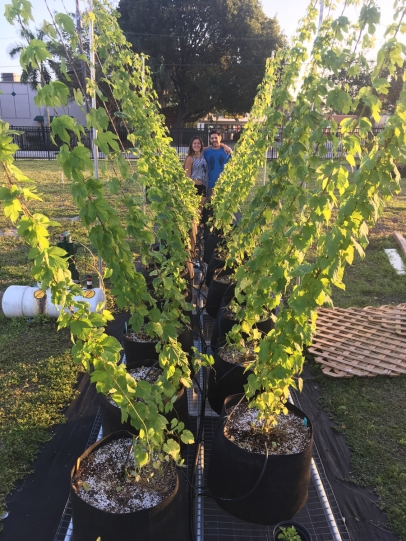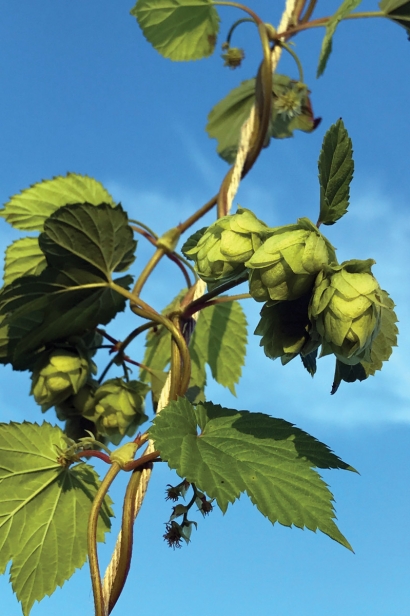Sunshine and Hop-iness: New Cash Crop in Florida?
Since the German Reinheitsgebot of 1516 (German Purity Law), it has literally been written in law that hops – along with water, grain and yeast – make up one of the four key components in beer.
What do hops do? The hop resin, containing alpha acids, imparts the bitterness in beer and acts as a natural preservative. Hop varieties in the market can lend unique earthy or vibrant aromas and flavors like citrus, pine, lemon and kiwi, to name a few.
Hops (Humulus lupulus) grow most abundantly in temperate areas described as hop-growing regions that carry a long lineage. Traditionally, Germany, England and the Czech Republic have grown most of the world’s hops. Their cooler, less-humid climates with sun-filled parts of the year are where hops thrive. The U.S. has a long hop-growing history, though most hop farms in the Northeast, including New York and parts of New England, stopped growing in the early 1900s due to mildew-related diseases and Prohibition. But in recent years, small hop producers are beginning to farm again in these areas. Oregon, Washington and Northern California have become the leading hop-growing areas in this country. In recent years, New Zealand and Australia have also become large producers, breeding unique styles popular among new brewers. Growing, processing and selling hops starts with the breeders and growers of these amazing hops.
Hops in the Subtropics
Clearly, Florida’s climate differs from areas where hops traditionally grow. But a few groups of botanists are up to the challenge of making this a hop-growing state. Liz Dutra and Josh Levitt of the Southern Hop Initiative and founders of Fort Lauderdale’s Invasive Species Brewing Company have spent the last season experimenting in South Florida. Dutra learned that members from the University of Florida Institute of Food Agriculture Sciences (UF/IFAS) had been growing hops in Central Florida over the past three years, so she and Levitt visited their farm and discussed their process. Two key components, cloned plants and hydroponics, have allowed them to successfully grow plants in South Florida. They can take hop plants that have been successful in warmer temperatures, clip a sample from the plant and utilize a gel hormone to treat it. The sample sprouts and becomes a clone of the original plant. Dutra acquired nine plants from UF/IFAS to start experimenting – three each of the Chinook, Cascade and Centennial varieties, all American hop strains used often in craft brewing.
Dutra and Levitt contacted the Urban Farming Institute in Oakland Park, who gave them space to place their plants. Because hops grow long bines – vine-like branches that crawl upwards of 20+ feet – the pair had to create their own trellis using cinderblocks and 1-inch conduit electrical wires. They planted the hops in mesh bags, which allows them to keep a dry base and the well-drained soil they prefer. It also allows them to maintain the ideal pH and provide the necessary minerals directly to the roots.
Harvest Time
So far this season, the Southern Hop Initiative was able to harvest around two pounds of hops from their plants. There’s still a lot to learn, says Dutra. “In Florida we get more light than other hop-growing areas. Where other areas may get one harvest per season, we were able to harvest twice.” It’s hard to say what this means in the long term. “The first year, hops don’t put off too much. Often, it takes the plants years to mature.” She also believes there may be an opportunity for a third harvest in the season.
There are plenty of obstacles here. Hops can fall victim to pests, including mites, weevils and other insects. Excessive heat can dry out the leaves and the hop cones if it’s too hot or plants are not watered consistently. Wind has made it a challenge to keep the hop bines attached to wires and the trelliswork upright. In commercial hop farming, hop growers cut down the bines each year to harvest the hop cones, running them through machines that separate the harvested cones from the rest of the plant. The next year, the plants grow a new bine. Currently, the Southern Hop Initiative is handpicking the hops, which is very labor intensive. It has allowed multiple harvests in one season, however, because the bine is still intact.
Even in its infancy, this prospect is exciting for brewers in South Florida. “The main reason we wanted to grow hops was for Invasive Species Brewing and brewing beers with boutique hops,” says Dutra. “Many of these hops are really hard to get, so we wanted to grow them ourselves.” This includes varieties like Triple Perle, Kashmir and Alpha acids, which all have unique flavor and aroma characteristics that lend themselves to Levitt’s brewing style.
Can Florida become the next hop growing area? “Nobody thought you could grow blueberries in Florida,” says Dutra. “Now it’s one of the largest producers in the country.” For beer drinkers and brewers in the Southeast, fresh hops could mean a unique regional flavor and more variety.







